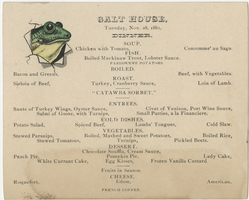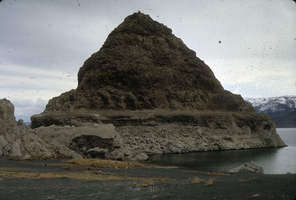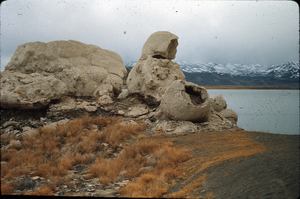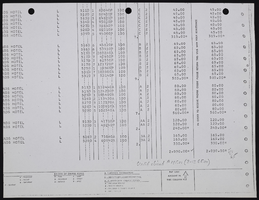Search the Special Collections and Archives Portal
Search Results

Interview with Duane L. Lawrence, June 24, 2004
Date
Archival Collection
Description
Text
Hoggard, Mabel, 1905-1989
Mabel Hoggard was the first licensed African-American educator in Nevada. Hoggard taught primarily first and second grade at various elementary schools throughout Clark County, Nevada from 1946 until her retirement in 1970. The schools she taught at included Westside Elementary, Matt Kelly Elementary, Highland Elementary, and C.V.T. Gilbert Elementary, all located in Las Vegas, Nevada.
Person

Grand Hôtel du Louvre, menu, December 16, 1875
Date
Archival Collection
Description
Text

Galt House, menu, Tuesday, November 28, 1882
Date
Archival Collection
Description
Text
Audio clip 1 from interview with Maurice "Maury" Halfon Behar, March 14, 2016
Description
In this clip, Maury Behar discusses how he survived the Holocaust.

Slide of a tufa deposit in Pyramid Lake, Nevada, circa 1970s
Date
Archival Collection
Description
Image

Slide of the rock formation known as The Squaw and Her Basket, Pyramid Lake, Nevada, circa 1970s
Date
Archival Collection
Description
Image

Los Angeles & Salt Lake Railroad Company double privy: architectural drawing
Date
Archival Collection
Description
From Union Pacific Railroad Collection (MS-00397). The scales are noted in the drawing. The bottom of the drawing says, "Material-Finish: All Finish Lumber Unless Otherwise Noted Shall Be [Opsas?] Wood Work Of Vault Shall Be O.P Rough. Exterior Of Privy Including Both Sides Of Door And Door Jamb: Also Wood Lattice Screen On All Sides Shall Be Painted With 3 Coats C.S. Lead & Oil Paint As Directed. Doors Shall Be Hung On 3 1/2" x 3 1/2" Botts. Doors Shall Be Provided With Rim Latch Knob Lock And Iron Barrel Bolt. Revisions: Added Vent Stacks, Seat Cover, Double Floor & Floor Shoe".
The bottom corner of the drawing states, "Union Pacific System L.A. & S.L.R.R. Double Privy 5'x8' With Lattice Screen. Ass't Chief Engineer's Office. Los Angeles, Calif. Drawn By E.C.B. Traced By E.C.B. Checked By F.W.G. Date June 14, 1926. Scale As Noted. Revised May 5. 1927. Drawing No. 15637".
Also written on the drawing: "Two to be built at East Yard, Calif. One ' ' Big Springs, Nev. ' ' Las Vegas, Nev. ' ' Borden, Utah. ' ' Elgin, Nev. 1927. ' ' Dry Lake, Nev. 1927. ' ' Wann ' ' 1928 [crossed out]."
Image
Billy Root oral history interview
Identifier
Abstract
Oral history interview with Billy Root conducted by Lisa Gioia-Acres on May 14, 2008 for the All That Jazz Oral History Project. Root begins by discussing his upbringing in Philadelphia, Pennsylvania where he developed an early interest in being a musician due to encouragement from his father, who was also a musician. He describes playing baritone saxophone in the Philadelphia Orchestra, performing at the Apollo Theater in Ella Fitzgerald's orchestra, and going on tour with a predominantly African American jazz band in the Southern United States during segregation. Root details his interactions and impressions of various celebrities, such as Frank Sinatra and Tony Bennett, attending Playboy parties, and eventually deciding to settle in Las Vegas, Nevada. He discusses working as a professional musician in Las Vegas, where he performed in such casinos as the Dunes and the Desert Inn. He concludes by discussing his retirement and his family.
Archival Collection

